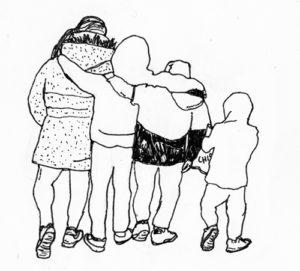Top-line Findings
Best Practices/Ideal Projects
Top-line Findings
1.Creative work can work in an open-play model, aimed towards supporting children’s resiliency.
2. Creative workers should aim to not give the children any more problems than they have
3. Ideally, creative and care teams should have a member, or access to a care-worker, who knows the children, their language, or their home culture.
4. Creative workers find ways to make such work meaningful, and it is, especially under such terms of general care.
Best Practices/Ideal Projects
A key finding element of any arts intervention with refugee children is to be supportive and open and not make their lives any more stressful or difficult than it already is.
To this end, it might be helpful to work with people who know the kids, who better know their context and the resources available to them in their housing, or who know their home cultures or languages.
An ideal aim for creative work with asylum seeking children is to help develop resiliency among the them. Here, to quote researchers Rebecca Halley and Mary Toll, resiliency is understood as a “resource for belonging” by children where they come to understand and appreciate the resources they innately have to engage their cultural and natural and urban environments- and develop their knowledge and aspirations in context. Here too, resilience is understood as a dynamic process that allows for positive choices and actions despite experiences of adversity.(1)
Studies suggest that creative projects with refugee children should be develop in collaboration with the them, ideally through extended dialog and exchange, in methods akin to consciousness raising. Let them identify the themes, questions and projects they want to explore.
According to McGregor and Rabab, artist-led projects with refugee children face steep challenges because of the time needed to get children on board, and for the kids to understand and appreciate the artistic goals. When developed by people more involved in the children’s lives, projects can be co-developed in a way to work with question in the room rather than just artistic or representational concept. In this way, the art and play can give space for unique and original voice, rather than simply repeating the known and unsurprising, the stereotypical and wrong. (2)
Often, open play and creative scenarios will function much better than results oriented work. This means that creative methods and materials can be introduced as items to play or openly create with, rather than as material to master towards very defined ends. It is important to agree to behavioral standards, and really discuss any disagreements around them. Be clear about rules and maintain them, in dialog. Material and processes should be introduced in as stress-free a manner as possible and provide the children have the possibility to play through their collective time together. Never demand that they must participate. Methods that allow everyone to positively engage with experiences that can shape and give order and meaning – (via relations, resources, possible interactions, potentials) are beneficial
In general, artistic and creativity and open play space can create an exceptional space of belonging- which can be important for displaced and migrant children. This can especially happen when projects develop and are developed upon the meaningful impulses, ideas and energy of the children. In this way, under many guises, such work can be understood as Participatory Arts-based Research.
Working with the traditional arts from countries of origin might be empowering.
(1) Toll, Mary & Halley, Rebecca. “The Role of Arts-Based Research in Creating Safe Spaces for Newcomer Refugees”. The Morning Watch: Educational and Social Analysis, Vol 46. No 1-2, Fall, 2018.
(2) McGregor, Elaine, & Ragab, Nora. The Role of Culture and the Arts in the Integration of Refugees and Migrants: Member State Questionnaires, 2016: European Expert Network, Maastricht.
…
